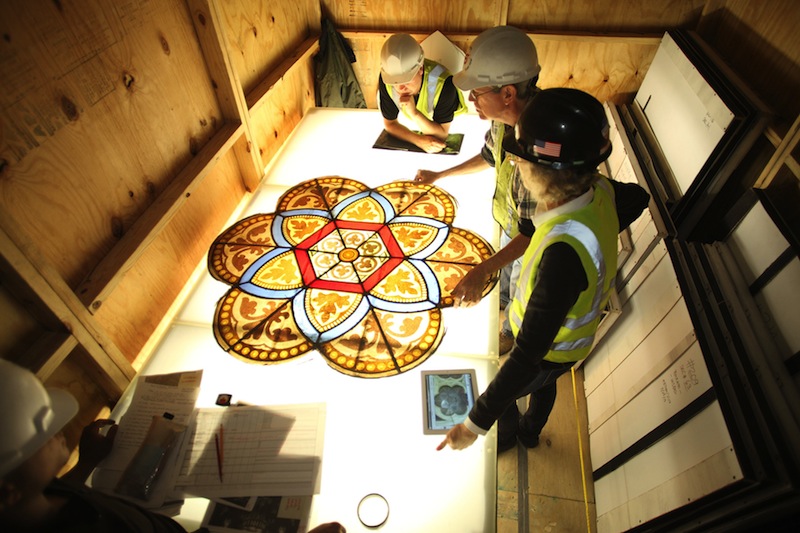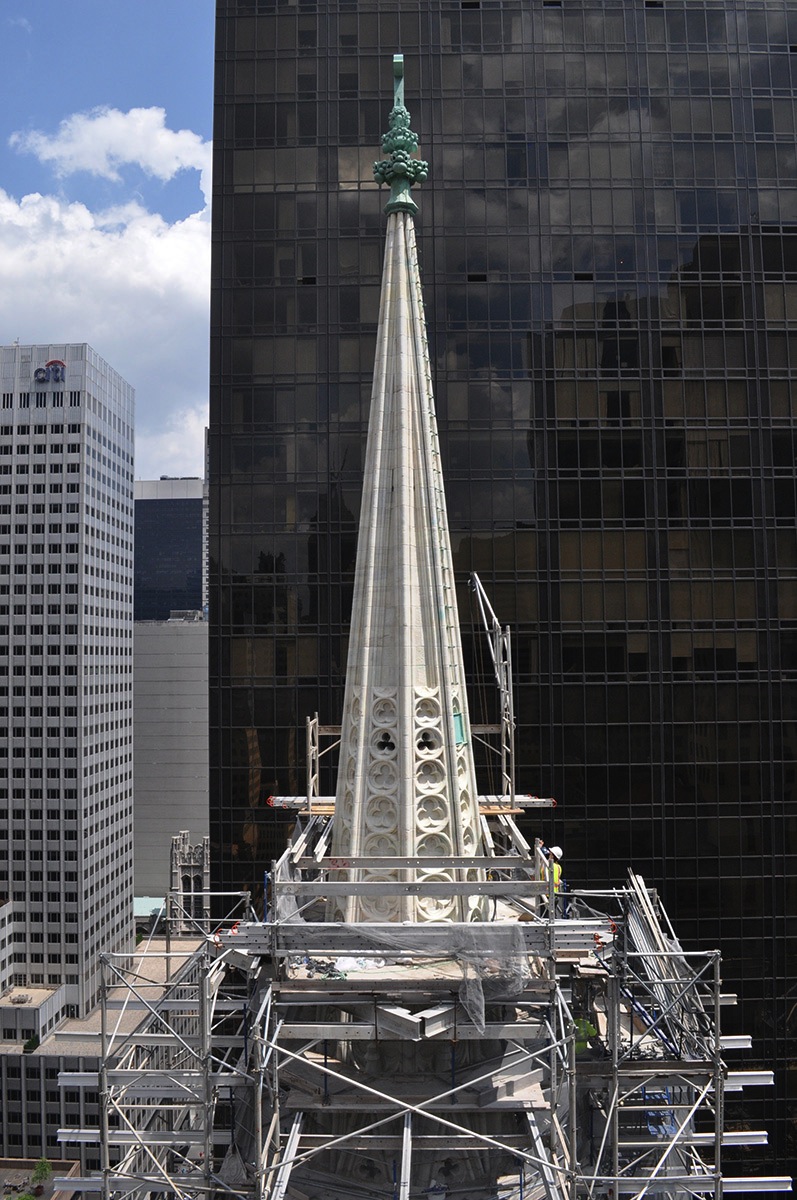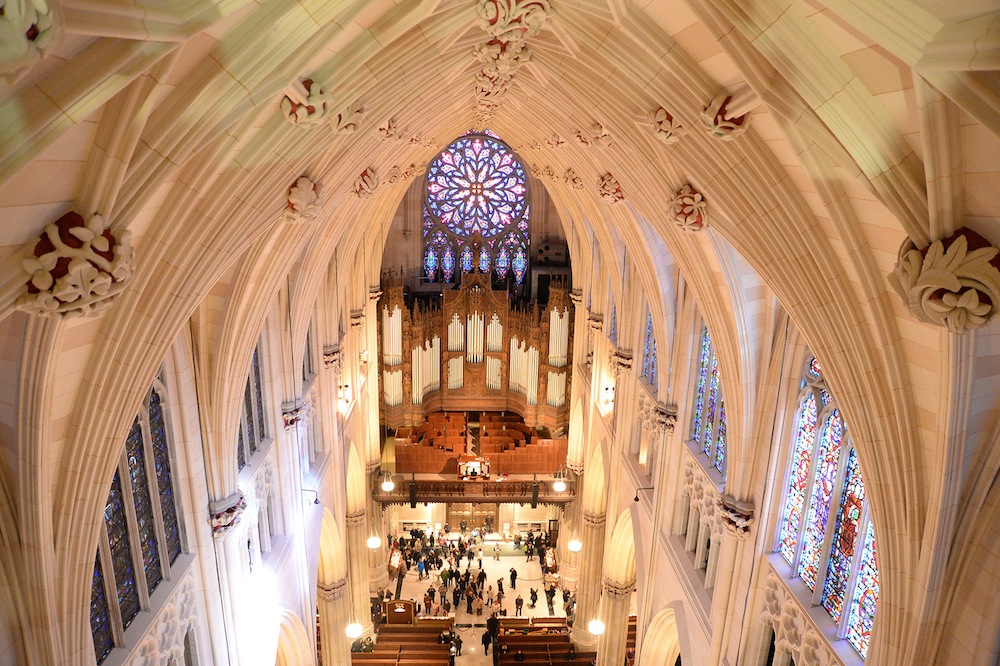Pope Francis is scheduled to visit New York City next month, and one of his stops will be the Cathedral of St. Patrick, where the Pontiff will lead an evening prayer service called Vespers on September 24.
Just in time for the Holy Father’s arrival, the neo-Gothic Roman Catholic Church and landmark in Manhattan will have completed a $177 million restoration, whose planning and reconstruction took nearly nine years. The complexity of this project required an unusually diverse array of consultants, from the Metropolitan Museum of Art to the New York Fire Department.
St. Patrick’s, which opened in 1888, had fallen into serious disrepair when, in 2006, Cardinal Edward Egan called for the building’s first major overhaul in 70 years. Murphy Burnham & Buttrick Architects developed a master plan that would allow the cathedral to stay open during the restoration.
A complex scaffolding system on a rolling platform moved down the cathedral’s interior nave in phases. That movement was coordinated, when possible, with exterior scaffolding to access stained glass windows from both sides and allow the Design team to review surfaces while the church was in use.
Autodesk’s BIM360 Field software managed this project, whose construction work got started in 2012 and included the tracking of more than 30,000 preservation treatments and repairs. This software also allows changes to the project’s scope to be communicated instantly to the Building Team.

Every square inch of the exterior was cleaned and repaired, including the twin spires that rise 330 feet about street level. On the exterior, stone was cleaned using the Rotec system, a micro-abrasive technology of low-pressure water, air, and crushed glass. Copper stains were removed with a clay poultice that draws impurities from the stone. On the interior, the team used multiple applications of Arte Mundit, a chemical cleaning latex peel.
Seventy-five stained glass windows with 3,700 panels were cleaned and repaired, too. The team installed new transparent protective glazing with laminated UV filtering, which let in more light and mitigated heat.
Because there was no system for putting out a fire in the attic above the nave except for a single standpipe, it was clear that a blaze in the attic would be too dangerous for firefighters to extinguish. So the team installed a high-pressure mist system as an alternative to a conventional sprinkler system. The system uses nitrogen to propel a small fraction of the water a conventional sprinkler system uses, suppressing a fire in minutes.
All new MEP and electrical systems are installed, including a geothermal system that required drilling 10 wells of up to 2,200 feet deep into the bedrock along the north and south sides of the Cathedral, a feat considering the network of subways, plumbing, and infrastructure underground. The geothermal system is expected to provide a 30% energy savings and reduce greenhouse gas emissions by 94,000 kilograms annually.
The Building Team included Building Conservation Associates (Restoration Consultant), Landmark Facilities Group (MEP Engineer), Silman Associates (Structural Engineer), Langan (Geotechnical Engineer), Robin Key (Landscape Architecture), Jaffe Holden Acoustics, Aramark, Arup Fire, Barkley Studio, Cerami & Associates, William Dailey Code Consulting, Construction Specifications, Inc., Ducibella Venter & Santore, Eckersley O’Callaghan & Partners, Femenella & Associates, Fisher Marantz Stone, Mary Kay Judy, GB Geotechnics, Heintges & Associates, Northeast Energy Services, PW Grosser Consulting, Slocum Cost Consulting, and VDA Associates.

Related Stories
| Aug 22, 2013
Energy-efficient glazing technology [AIA Course]
This course discuses the latest technological advances in glazing, which make possible ever more efficient enclosures with ever greater glazed area.
| Aug 14, 2013
Green Building Report [2013 Giants 300 Report]
Building Design+Construction's rankings of the nation's largest green design and construction firms.
| Jul 29, 2013
2013 Giants 300 Report
The editors of Building Design+Construction magazine present the findings of the annual Giants 300 Report, which ranks the leading firms in the AEC industry.
| Jul 19, 2013
Reconstruction Sector Construction Firms [2013 Giants 300 Report]
Structure Tone, DPR, Gilbane top Building Design+Construction's 2013 ranking of the largest reconstruction contractor and construction management firms in the U.S.
| Jul 19, 2013
Reconstruction Sector Engineering Firms [2013 Giants 300 Report]
URS, STV, Wiss Janney Elstner top Building Design+Construction's 2013 ranking of the largest reconstruction engineering and engineering/architecture firms in the U.S.
| Jul 19, 2013
Reconstruction Sector Architecture Firms [2013 Giants 300 Report]
Stantec, HOK, HDR top Building Design+Construction's 2013 ranking of the largest reconstruction architecture and architecture/engineering firms in the U.S.
| Jul 19, 2013
Renovation, adaptive reuse stay strong, providing fertile ground for growth [2013 Giants 300 Report]
Increasingly, owners recognize that existing buildings represent a considerable resource in embodied energy, which can often be leveraged for lower front-end costs and a faster turnaround than new construction.
| Jul 2, 2013
LEED v4 gets green light, will launch this fall
The U.S. Green Building Council membership has voted to adopt LEED v4, the next update to the world’s premier green building rating system.
| Jul 1, 2013
Report: Global construction market to reach $15 trillion by 2025
A new report released today forecasts the volume of construction output will grow by more than 70% to $15 trillion worldwide by 2025.
| Jun 28, 2013
Building owners cite BIM/VDC as 'most exciting trend' in facilities management, says Mortenson report
A recent survey of more than 60 building owners and facility management professionals by Mortenson Construction shows that BIM/VDC is top of mind among owner professionals.














